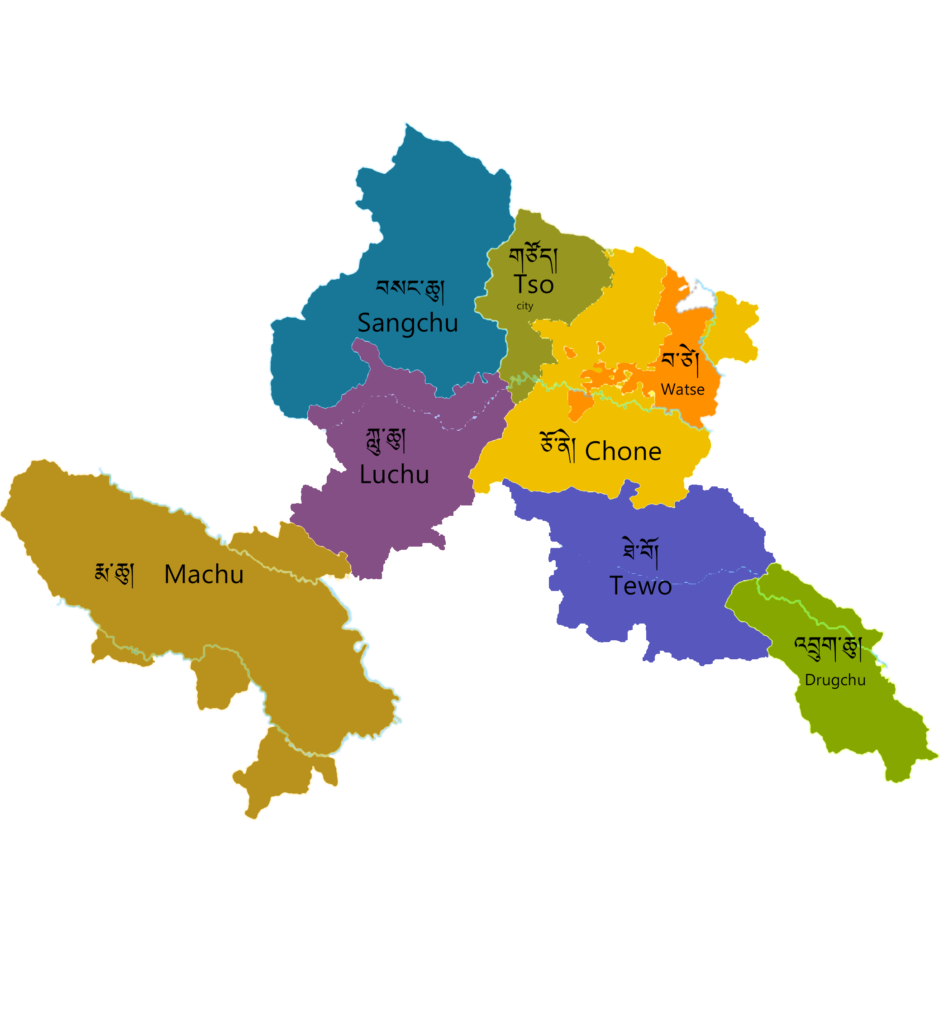Hezuo (also known as Tsö in Tibetan) is the capital of Gannan Tibetan Autonomous Prefecture in Gansu Province, China. Positioned at an elevation of about 2,900 meters (9,500 feet), Hezuo serves as a central point for Tibetan culture, religion, and commerce in the region. It’s particularly famous for Milarepa Tower, a unique nine-story Buddhist tower dedicated to the famous Tibetan yogi and poet Milarepa, as well as for its scenic beauty and a deep sense of Tibetan tradition.
Milarepa Tower
The Milarepa Tower is a nine-story structure located in the center of Hezuo. Built in honor of Milarepa, a revered Tibetan poet and saint, this iconic tower is a significant spiritual site in Tibetan Buddhism. Each floor of the tower is decorated with intricate murals and statues, representing various stages of Milarepa’s life and teachings.
Visitors can explore each level of the tower, where they’ll find paintings and sculptures depicting Buddhist legends and scenes from Milarepa’s journey. From the top, visitors have a panoramic view of Hezuo and the surrounding landscapes, making the tower both a cultural and scenic attraction.
Hezuo Monastery (Tsö Monastery)
Hezuo Monastery, or Tsö Monastery, is a significant Gelugpa (Yellow Hat sect) Tibetan Buddhist monastery. It holds an important place in the religious life of the region and is an active center for worship, study, and meditation for local monks and laypeople.
monastery features beautifully painted murals, grand assembly halls, and Buddhist relics. During certain Tibetan festivals, the monastery hosts traditional Cham dances and other rituals, drawing pilgrims from across the Tibetan plateau. It’s a serene place to observe Tibetan Buddhist practices and learn about the teachings of the Gelugpa tradition.
Gannan Grasslands
Hezuo is surrounded by the lush, rolling Gannan Grasslands, which stretch across this part of the Tibetan plateau. These grasslands are home to Tibetan nomads and offer a pristine natural environment for exploring.
Visitors can take scenic hikes or horseback rides through the grasslands, and during the warmer months, you’ll likely encounter Tibetan herders with their yaks, sheep, and horses. The grasslands are especially stunning in summer when wildflowers bloom across the meadows.
Tibetan Buddhist Festivals
Hezuo hosts various Tibetan festivals, particularly during Losar (the Tibetan New Year) and Monlam (the Great Prayer Festival). These events showcase colorful ceremonies, ritual dances, and traditional Tibetan music, drawing both local Tibetans and visitors to celebrate.
The Monlam Festival at Hezuo Monastery is particularly noteworthy, where monks and pilgrims gather for days of prayer, rituals, and Cham dances. The festival includes a public display of a giant Thangka painting, offering blessings to the community. These festivals are a vibrant time to experience Tibetan spirituality and community life.
Hezuo Local Markets and Tibetan Crafts
The town’s market areas offer an array of Tibetan handicrafts, including jewelry, Thangkas, prayer beads, and traditional Tibetan clothing. The markets give insight into the daily life of the town and serve as a meeting place for the Tibetan, Hui, and Han communities of the region.
Visitors can browse the stalls, chat with local artisans, and pick up unique souvenirs. The market is an excellent place to sample Tibetan food like butter tea, tsampa (roasted barley flour), and yak meat dishes. It’s also an opportunity to observe the unique mix of Tibetan and Hui cultures that characterize Hezuo.
Bajiao City Ruins (Bajiao Cheng)
Located outside Hezuo, the Bajiao City ruins (also called “Octagonal City”) are the remains of an ancient fortress town. It is named for its unique eight-sided shape, believed to have been built during the Ming Dynasty to defend against invaders.
Though in ruins, the walls and layout of Bajiao City are still visible, giving a glimpse into the historical defensive structures in the region. The site provides a fascinating contrast to the otherwise Tibetan cultural focus in Hezuo, reflecting the area’s strategic importance and historical diversity.
Administrative Divisions of Gannan Tibetan Autonomous Prefecture

| Serial No | Name of Counties | Name in Tibetan | Area (km2) |
| 1 | Hezuo (Tsol) | གཙོས་གྲོང་ཁྱེར། | 2670 |
| 2 | Lintan (Lintan) | ལིན་ཐན་རྫོང་། | 1557 |
| 3 | Zhuoni (Jone/Chone) | ཅོ་ནེ་རྫོང་། | 5694 |
| 4 | Zhouqu (Drukchu) | འབྲུག་ཆུ་རྫོང་།ང་ | 3010 |
| 5 | Diebu (Tewo) | ཐེ་བོ་རྫོང་། | 5108 |
| 6 | Maqu (Machu) | རྨ་ཆུ་རྫོང་། | 10190 |
| 7 | Luqu (Luchu) | ཀླུ་ཆུ་རྫོང་། | 5298 |
| 8 | Xiahe (Sangchu) | བསང་ཆུ་རྫོང་། | 6674 |
| Serial No | Name of Counties | Name in Tibetan | Area (km2) |
| 1 | Tianzhu (Pari) Tibetan Autonomous County | དཔའ་རིས་བོད་རང་སྐྱོང་རྫོང༌།་། | 7,149 |
Tips for Visiting Hezuo
- Best Time to Visit: Spring and autumn are the best seasons to visit Hezuo, as the weather is mild and the grasslands are vibrant. Summer can be rainy, but it’s still a popular time because of the lush scenery.
- Altitude Awareness: Hezuo is situated at nearly 3,000 meters, so visitors may feel mild altitude sickness. Take it easy on the first day, stay hydrated, and avoid heavy physical exertion until acclimated.
- Respect Local Customs: When visiting monasteries and sacred sites, dress conservatively, be quiet, and refrain from taking photographs in temples without permission. Showing respect for local customs enhances the experience and is appreciated by the Tibetan community.
- Accommodation Options: Hezuo offers a range of hotels and guesthouses, from basic Tibetan-style lodges to more comfortable accommodations. Some Tibetan guesthouses offer an immersive experience with traditional meals and cultural exchanges.
Hezuo is a fascinating destination for those interested in Tibetan Buddhism, history, and nomadic culture. With its rich spiritual heritage, festivals, and breathtaking landscapes, Hezuo offers a unique window into the Tibetan world within Gansu province.
 Tibet World Travel Tibet Tour, Tibet Trip, Tibet Travel, Tibet Train, Tibet Trekking,
Tibet World Travel Tibet Tour, Tibet Trip, Tibet Travel, Tibet Train, Tibet Trekking,
